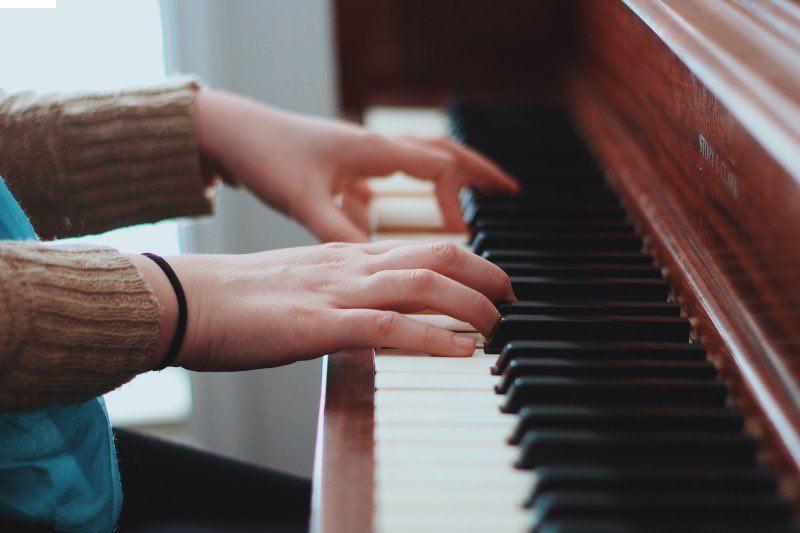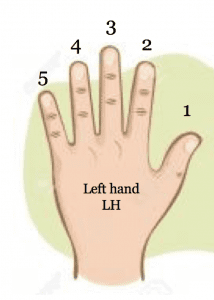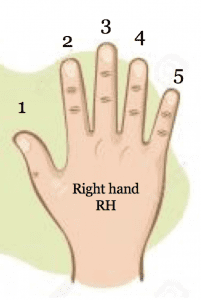Learning to play the piano is a fun and lifelong journey. Here, you’ll find a helpful piano fingering chart, fingering exercises, and some general piano playing advice that I’ve seen help musicians over the years.
One of the first steps to learning the piano is learning your piano finger numbers. These little numbers located above or below the notes are crucial in knowing where to position your hand and which notes to play. Below is the fingering chart and some exercises for the beginner pianist.
Let’s Get Started With a Piano Fingering Chart
Here, you’ll find the numbers associated with your piano playing fingers. Take a few minutes to remember this piano fingering chart, because they’ll come in handy later. Even very advanced piano players refer to their different finger numbers when deciding how to play complex pieces.
Three Finger Exercises to Help You Become Acquainted With Your Fingers:
- Place your hands on a table (or any hard surface) and make sure your hands are in good piano-playing position. Lift one finger as high as it can go, hold it up for 3 seconds, then put it down. Repeat 5 times for each finger.
- Try the following examples on a table. Do each example in each hand separately. As a bonus, play the examples in both hands simultaneously or on the keyboard (choosing any five keys).
- 1 2 3 4 5 4 3 2 1
- 1 2 1 2 3 4 3 4 5 4 3 2 1
- 3 2 1 2 3 4 3
- 1 3 2 4 3 5 1
- 5 3 4 2 3 1 1
- 1 5 1 5 5 3 1
- Ask a friend or family member to make up random numbers (1-5) for you to play!
- Ask a friend or family member to call out random numbers from 1 to 5. Wiggle that finger. They can even ask for two fingers or more fingers at once!
Fingering Advice:
- Learning the notes is also about learning the piano fingering! Students often forget to check the finger numbers in their pieces.
- Beginner pieces are hand-friendly, meaning notes are usually close together and do not span more than five keys in each hand. Therefore, the fingering can help you know which notes to play. Make sure you position the fingers on the correct keys before starting the piece and know which finger corresponds to which key. As pieces become more advanced though, they will require extending the hand and changing hand positions within a piece.
- The first and fifth fingers (thumb and pinky) are short fingers and a common problem that occurs is finding yourself dropping your hand position in order to reach the keys. To maintain a correct hand position, make sure to play on the side of the nail for the thumb and the tip of the finger for the pinky.
- Remember that the hands are opposite: 1 to 5 in the right hand means starting at the thumb and moving right, while 1 to 5 in the left hand means starting at the thumb and moving left.
- Fingers should not twist or flip over each other. The only finger that can cross under the hand is the thumb. Therefore, the only finger that allows others to cross over it is also the thumb.
- Avoid thumbs on black keys when possible. The thumb is short, and trying to play black keys with the thumb will shift your hand into an uncomfortable position.
- Octave leaps should be played with 1 and 5.
Other General Piano Playing Advice
“A dream does not become reality through magic; it takes sweat, determination, and hard work.” Colin Powell
We are always excited when learning something new. Students who come into their first lessons in piano are usually bouncing in their seats, constantly running their hands over the keyboard, and dreaming of all the wonderful music that they cannot wait to play. At some point later on, frustration kicks in as the pieces become more challenging and require extra practice at home. Always remind yourself (or your child) that any skill worth achieving takes effort, diligence, and practice, and learning the piano is definitely worth this time and effort.
Here are some piano playing advice to guide you (or your child) on this journey:
On Practicing:
- The two most important things during practice: 1) diligence/consistency, and 2) focus. It is better to practice a little bit every day rather than a large chunk one or two days each week. Additionally, one must be focused and attentive during their practice for maximum efficiency. If you are thinking about your phone or what to eat for dinner, you are not engaged in your work and will accomplish less!
- It is easier to learn correctly the first time than to unlearn a bad habit. To correct a bad habit, you must use twice as much effort to consciously catch and change the habit.
- Besides the brain, the ears are the next most important organ for playing piano. They are the ones that tell you about wrong notes, if you sound good or bad, or if you have wrong rhythm. Make sure your ears are awake at all times, especially during practice.
- Constantly check for a curved hand position, curved fingers when playing, and relaxed shoulders.
On Learning New Pieces:
- Learn in small chunks, hands alone first. The brain cannot process too much information at once, so trying to cover more music than you can handle in a day may have negative effects.
- Find patterns in the music. Before you even begin finding the notes on the keyboard, eyeball the whole piece to see if you find repeating patterns. This will help you organize the music in your mind.
- Start slow. We often want to learn something as fast as we can, and engrain bad habits along the way. Remember, it is about the journey!
- Count the rhythm out loud in your practice.
On Rhythm:
- Rhythm is very important. Incorrect rhythm can make a piece sound entirely different.
- When counting out loud, do not count in a lazy or sleepy manner. Be confident, strict in keeping a steady beat, and spend time to calculate any rhythms you are unsure of.
- Counting and playing is difficult at first, but worth the effort. Without precise rhythm, music becomes disorganized and will not make sense.
Most Importantly, Practice!
Remember, practicing the piano and learning from an expert instructor are two of the best ways to improve your skills.
Use the tips above to help get started with your piano adventures, and don’t hesitate to bookmark this page and refer back to the piano fingering chart above when need be.
Alison Chiang




